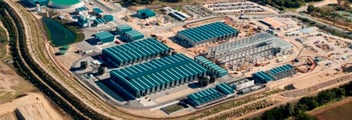Black & Veatch keeps sustainability at the core of their future development
With water utilities round Australia working towards more sustainable service solutions, global engineering and construction company Black & Veatch have launched a 2020-2023 Sustainability Strategy to better align with its clients key objectives.
Outlined in Accelerate 0, the strategy focuses on creating tangible progress towards more sustainable practices within the sectors it services, including water, oil and gas, government and data.
Black & Veatch Australia & NZ Managing Director Water James Currie said the strategy launch coincides with a major shift the company has taken towards renewable energy solutions.
“Almost in parallel with the launch of our 2020-2023 Sustainability Strategy, we announced that we are withdrawing from any new assignments related to coal-fired power generation, which has been a core part of Black & Veatch's business for most of its 100 years or so,” he said.
“The company was founded in 1915. And really, coal-fired power generation has been a large part of its business, traditionally. This has marked a really significant change in direction for the company with an increasing focus on renewable energy.”
Within Australia, Black & Veatch has been involved in the Victorian desalination plant, the original groundwater recharge trials for Water Corporation and was part of the team that delivered the Bundamba Advanced Water Treatment Plant as part of the Western Corridor scheme.
“As with everyone that's working in the water sector, we’re increasingly seeing sustainability as being a very important part of virtually every project that we do,” Currie said.
“The nexus between energy and water is an important issue for us, given the core businesses that we have. So we're always looking to do projects in a way that’s energy efficient, where we can look at reducing the carbon footprint of the project.
“Our two principal clients at the moment are Melbourne Water and Water Corporation. Recent works have included the W2W Alliance with Water Corporation, and the Eastern Treatment Plant tertiary upgrade with Melbourne Water.”
Building the strategy involved an in-depth materiality assessment, which aimed to better understand the elements of sustainability that are most important to the company’s employees and strategic stakeholders, Currie said.
“The materiality assessment was a key part of our sustainability strategy. We conducted a survey among our workforce across the whole organisation to identify the key focus areas for the development of the strategy,” he said.
“This process helped inform not just what was important to us and our stakeholders, but also where we felt we could make the most difference.
“The assessment really focused on two limbs: what are the important issues? What issues can we do something about? But also, how can we use our project work to progress the sustainability initiatives and how do we do it?”
The process identified a number of key focuses, including business ethics and anti-corruption, health, safety and security, project sustainability, learning and development, and environmental stewardship.
“There are the obvious focuses for sustainability, like environmental stewardship. But sustainability is quite a lot broader than that. We identified social progress as an important area to be engaged in,” Currie said.
“But the question of governance is also a very important issue for the company, too. We engage with clients, we share best practises, we're very open about sharing what we're doing in one location with clients elsewhere. We very often look to have clients collaborate with us.”
Currie said Black & Veatch looks forward to making the most of the transition toward sustainable solutions as its client base continues to grow into the renewable energy sector.
“The issue of energy management for water utilities is growing in importance. The renewables sector is definitely growing. It's going to fill the hole left by the withdrawal from coal-fired power generation,” he said.
“And given Black & Veatch is a company working alongside industries that use high amounts of energy, there are increasing opportunities for us to align with the commitments that all of our partnering companies are making about reducing their greenhouse gas emissions.”
Currie said the company is also seeing other clients from industries like the oil and gas sector explore alternative fuels like ammonia as a transporter of hydrogen and its role in decarbonisation.
“The drive for sustainability is creating many opportunities to innovate with our clients and build sustainable infrastructure,” he said.
“We are looking forward to collaborating with the water industry to achieve its objectives for the sustainable use of water, in the areas of management, sourcing, consumption, reuse and discharge.
“During 2021, we will also be conducting a water use assessment for the infrastructure projects we work on and using it to inform future actions.”

